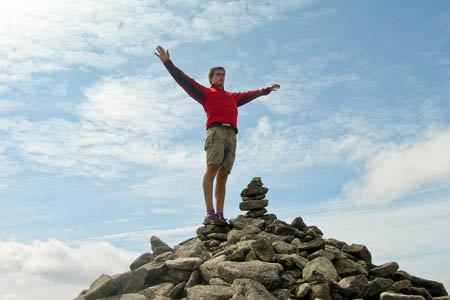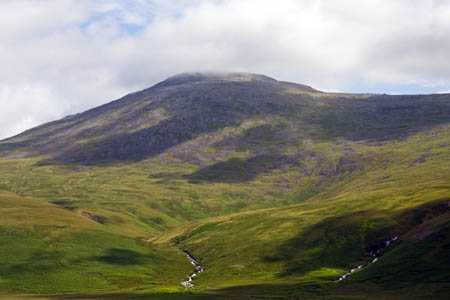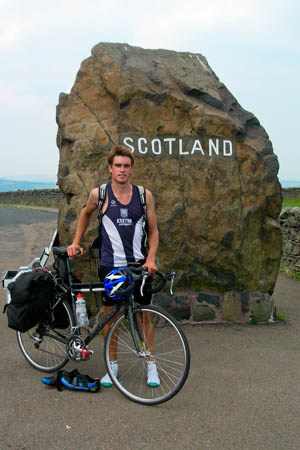
Jonny Muir on his first top, Brown Willy
Why? It’s the hardest question. The who, what, where, when and even the how can usually be dispatched with a cursory examination of basic facts. But why?
It’s a question I’m often asked when I describe a particularly difficult – and potentially dangerous – moment from a hillwalking adventure. It’s hard to answer to those poor mortals who have never set foot on a mountain, and it’s the question at the heart of a book by a young journalist who undertook a madcap venture three years ago which took him to some of the most wondrous – and boring – places in our varied land.
Heights of Madness is an account of Jonny Muir’s expedition to the highest points of the UK’s historic counties. There are 92 of them, and Jonny set himself the task of achieving their summits in as many days though, in reality, he did have a few days off away from the trail trying to keep his girlfriend and family happy, attending a job interview and all the other mundanities that distract from a heroic quest.

Heights of Madness
The book pitches straight in with a journey to the end – very nearly: a scary encounter with ‘mountain madness’ in a storm on Carn Eige, 91 days into his quest. Most hillwalkers will identify with the mixture of panic, irrationality and fear that has, at some time, gripped all of us in the midst of a bad expedition up a mountain that just seems to have it in for you.
Jonny’s chosen mode of transport is a bike; walking the whole route would have proved just too slow, but the actual journey to the county tops is almost invariably made on foot.
This is no guide book: there are no ‘go 300 yards from the third cairn’ instructions to the tops and the writing is refreshingly light. So many books by outdoor luminaries can seem ponderous and pedestrian and this 300-page paperback avoids such pitfalls. Think: Pete McCarthy and Tony Hawks with a smattering of Brysonesque pithiness.
And so it’s entirely appropriate that Jonny’s first jaunt is up Brown Willy on Bodmin Moor, achieved as the military guns fall silent to allow the Ten Tors event to take place. Along with Fan y Big, the two provide the two ‘Ooh, Matron’ moments on the tour.
Along the way, there are malodorous snorers in youth hostels, roadkill galore, amorous Swiss men and punctures aplenty.
The book is a bonk-buster too, though not in the sense most of us understand. Bonking, for the non-cyclist – me included – is the runner’s equivalent of ‘hitting the wall’ and, as you would expect on such a journey, there’s bonking everywhere.
The book is certainly a celebration of Britain – often sneered at – an intrinsically beautiful place on the whole, even if its inhabitants can’t be so described.
Some of the places will be familiar to grough readers. Milk Hill, recently surveyed by the trio of amateur hill sleuth under the gaze of the television cameras, is Wiltshire’s highest point and was once the site of the biggest crop circle ever recorded, an event that cost the farmer whose crop was flattened by the perpetrators thousands of pounds.
The southern tops come thick and fast and are not always that obvious. Jonny ingratiates his way into a locked water company compound only to realise he’s actually in Hertfordshire rather than his desired county of Middlesex.
On his round-the-nation odyssey, Jonny encounters sex and violence in a youth hostel – even if it is only on television; a man with Tupperware boxes who is intent on talking to people on other hill tops by radio – Summits on the Air – an even greater candidate for the question ‘why?’ and rediscovers his hatred of camping.
Of course, the venture sounds thrilling and exciting: soaring mountain tops and vertiginous peaks but much of England is unremarkably unelevated. Huntingdonshire’s Boring Field, at 80m, lives up to its name and Lincolnshire’s high point is a cabbage patch.

Scafell: not Scafell Pike
There’s a feeling throughout that Jonny has not always done enough homework about how to approach his targets. Members of the Lake District mountain rescue teams may wish to skip the first half of the book and turn straight to page 170 for an insight into the mentality of the unprepared. Jonny had been lost twice already on Scafell Pike and even on his third attempt he makes the fundamental error of failing to distinguish between Wainwright’s siren call to the delights of Scafell when he should be trying to locate its neighbour Scafell Pike.
The author comes close to finding the answer to the hardest question in the Lake District, with an amalgam of the Kirkstone Pass, Striding Edge and Glenridding Beck.

Jonny enters Scotland, on day 54
But self-doubt envelops him as he enters Scotland and it is often a question of mind over matter to get going the next day.
There are other odd venturers out there, including a man crossing Scotland with a Scrabble board, searching for a new opponent in a different pub each night. Why?
Northern Ireland’s mountains may be bleak, but Jonny finds the hospitality warm, from the Porsche driver who stops to help him fix a puncture, to the cafe waitress who chips in with cash for his breakfast when he realises he only has 14p.
Although there is at times a sense of desperation in the quest, humour is usually only a couple of turns of the page away. The description of Jonny’s battle with Scotland’s secret army – the midges – is particularly amusing and will strike a chord with every walker who has had to fight his or her own battle with the mighty biters.
Jonny’s most northerly point is Ronas Hill on Shetland which, surprisingly has a visitor’s book on its summit. In contrast to the obvious comments: ‘thick mist’, ‘very windy’, ‘wet’, ‘miserable’ is Jonny’s view, finally perhaps the answer to the question running through the book.
“Sometimes it is not simply what you see, but how what you see makes you feel. Standing utterly alone, in the brutal jaws of the Atlantic wind, nothing could match this.
“I attempted to draw every moment into my brain. I wanted to remember the ferocious wind, the overwhelming sense of satisfaction and purpose. I wanted to bottle this feeling and put it in a cupboard, so I could feel it again and again.”
These moments, experienced by so many of us on the hills, are transitory. We can look at our photographs – though Jonny can’t; he lost his camera on Shetland – and have our Proustian ‘madeleine moment’ and savour the memory, but the event itself can last just a few seconds.
Perspective kicks in quickly when Jonny realises that, coinciding with his previously mentioned brush with death in August 2006, police were thwarting the attempt at what would have been one of Britain’s biggest mass murders, the plot to blow up ten transatlantic flights. Out there on the mountains, only you and nature matter. It’s easy to forget that humanity’s many endeavours are going on still, in the other world.
It comes as no surprise to find George Mallory’s ‘because it’s there’ riposte in Jonny’s epilogue. It’s a natural conclusion to the question why? In an era when the highest, fastest, deepest, slowest have all been achieved, the human spirit sometimes demands inventiveness in its quests. Jonny’s answer was a 5,000-mile trip round the UK and, thankfully, there was enough laughter en route to make a thoroughly readable book.
It is also proof of Sir Edmund Hillary’s statment that: ‘adventuring can be for the ordinary person with ordinary qualities’.
Gripes? Well, seasoned stats demons will decry the lack of detail of the tops. There is no table of the county high points and no index. Equally, anyone looking for a technical description of the cycling travails will be disappointed, but that misses the point. This is not a specialist’s book; it’s an amusing account of a whacky challenge. Jonny’s writing style is easily readable and hill lovers will find enough interest and ‘oh yes, I know the place he’s talking about’ episodes to keep the interest going. Recommended.
Heights of Madness by Jonny Muir, published by Metro, paperback £7.99
The Piglit
18 October 2009Another case of ADHT masquerading as a personal achievement.